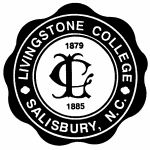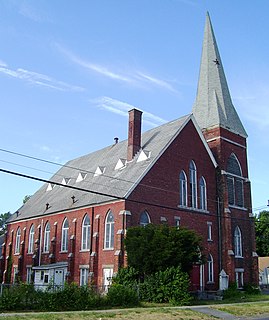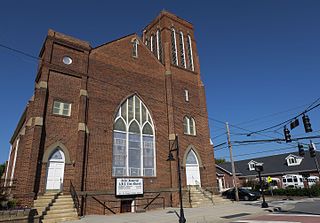
Livingstone College is a private, historically black Christian college in Salisbury, North Carolina. It is affiliated with the African Methodist Episcopal Zion Church. Livingstone College is accredited by the Commission on Colleges of the Southern Association of Colleges and Schools to award the Bachelor of Arts, Bachelor of Science, Bachelor of Fine Arts, and Bachelor of Social Work degrees.

Durham Memorial A.M.E. Zion Church, formerly known as St. Luke's A.M.E. Zion Church until the late 1950s, is a historic African Methodist Episcopal Zion Church located at Buffalo in Erie County, New York. It is a brick church constructed in 1920. It is the oldest surviving church associated with the Buffalo A.M.E. Zion congregations.

The Mount Zion Methodist Episcopal Church is a historic Methodist church located in Union Township, Delaware County, Indiana. It was built in 1867, and is a modest, one-room, brick church with a reconstructed bell tower. It measures 46 feet by 36 feet and sits on an uncut Indiana limestone foundation.

Wall Street Methodist Episcopal Church, now the home of the African Methodist Episcopal Zion Church, is a historic Methodist Episcopal church located at 69 Wall Street in Auburn, New York, United States. It is a large Gothic Revival style brick and limestone structure built in 1788, and renovated in the 1887. The facade is dominated by a square tower topped by a broach spire. It is an example of an auditorium plan church, popular in church design from the 1880s to 1920s.
Mount Zion Methodist Church, or variations, may refer to:

St. James AME Zion Church is a historic African Methodist Episcopal Zion church located at Ithaca in Tompkins County, New York. It is a two-story, frame church structure set on a high foundation and featuring a four-story entrance tower. The church structure was begun in the 1830s and modified many times since. The original stone meetinghouse was built in 1836 and is believed to be Ithaca's oldest church and one of the oldest in the AME Zion system.

Smith Metropolitan AME Zion Church is a historic African Methodist Episcopal Zion Church located at Smith and Cottage Streets in Poughkeepsie, Dutchess County, New York. It is the oldest predominantly African-American church in Dutchess County, NY. The church was a part of The Underground Railroad led by Civil Rights leader Harriet Tubman. The first black female judge in America, Ms. Jane Bolin, was a member of this church, along with other influential people. The church has experienced phenomenal new growth under the leadership of their Pastor, Reverend Edwrin Sutton. The Church as a ministry began in 1836. The church building was built between 1908 and 1910, with the parsonage added in 1914. The one-story, rectangular Gothic Revival church has an attached two-story bell tower topped by a pyramidal roof and a raised basement. The brick building features pointed arched openings and stained glass windows.

The Metropolitan African Methodist Episcopal Zion Church is a historic Methodist Episcopal Church at 2051 Main Street in Hartford, Connecticut. This High Victorian Gothic structure was built in 1873-74 for an Episcopal congregation, and has since 1926 been the home to the city's oldest African-American congregation, which was established in 1833. The church was listed on the National Register of Historic Places in 1994.

Lomax African Methodist Episcopal Zion Church is an historic African Methodist Episcopal Zion church located at 2704 24th Rd. South in Arlington, Virginia. It was built in 1922, and is a one-story, three bay by six bay, brick church building on a parged concrete foundation. It features two unequal-sized crenellated towers and brick buttresses along the facade and side elevations in the Late Gothic Revival style. Also on the property are two contributing resources, including a cemetery dating from circa 1894, and a parsonage built in 1951. The cemetery contains approximately 107 interments.

Zion African Methodist Episcopal Church is a historic African Methodist Episcopal (AME) church and cemetery located at Camden, Kent County, Delaware. It was originally built in 1845 and re-built after a fire in 1889. The one-story, gable roofed frame Classical Revival-style church rests on a brick foundation. It measures 28 feet, 3 inches, wide and 36 feet, 2 inches in length. The ground around the church has been used as a cemetery since the church was established. The church is an important focal point of the community of Star Hill, an early community of African American settlement in Kent County. Zion was the first African Methodist Episcopal church in Camden, and is the mother church of nearby Star Hill AME Church.

St. Peter's AME Zion Church is a historic African Methodist Episcopal church located at 615 Queen Street in New Bern, Craven County, North Carolina. It was built between 1923 and 1942, on the site of the 1914 church building which was destroyed by fire in 1922. It is a large three bay by seven bay, rectangular brick church building in the Late Gothic Revival style. It features a gabled nave flanked by two-story truncated stair towers. Also on the property is the contributing 1926 parsonage; a 2 1/2-story, frame American Craftsman style dwelling. It is known within the denomination as the "Mother Church of Zion Methodism in the South," and the oldest existing African Methodist Episcopal congregation in the South.

Goler Memorial African Methodist Episcopal Zion Church, also known as Old Goler, is a historic African Methodist Episcopal Zion church located at 630 Patterson Avenue in Winston-Salem, Forsyth County, North Carolina. It was built in 1918–1919, and is a rectangular brick building in the Late Gothic Revival style. It features a gable-front block flanked by two square brick towers and stained glass windows. A two-story annex was built in 1946. In 1942, the Goler Metropolitan AME Zion Church congregation split from the Goler Memorial African Methodist Episcopal Zion Church.

Goler Metropolitan AME Zion Church, originally known as East Fourth Street Baptist Church, is a historic African Methodist Episcopal Zion church located at 1435 E. Fourth Street in Winston-Salem, Forsyth County, North Carolina. It was built in 1924, and is a front-gabled brick church with two prominent domed towers and flanking one-story hipped-roof wings in the Classical Revival style. The front facade features a prominent pedimented porch supported by stuccoed Doric order columns and Ionic order pilasters. The interior is based on the Akron Plan. The building was acquired by an African-American congregation split from the Goler Memorial African Methodist Episcopal Zion Church in 1942. The congregation changed their name to Goler Metropolitan A.M.E. Zion Church in 1953.

Center Street A.M.E. Zion Church is a historic African Methodist Episcopal Zion church located on S. Center Street in Statesville, Iredell County, North Carolina. It was built in 1903, and is a one-story, three bay by seven bay, Late Gothic Revival style brick building. It has a steep gable roof sheathed in pressed tin and features two corner entrance towers of unequal height and a large, pointed arch stained glass window.

Mount Carmel A.M.E. Zion Church & Campground is a historic African Methodist Episcopal Zion church camp in Heath Springs, South Carolina, Lancaster County, South Carolina. It was established in 1866 and consists of a complex of approximately 55 small "cabins" or "tents" and the brick church of Mt. Carmel A.M.E. Zion Church is located in the general form of a rectangle. Mount Carmel A.M.E Zion Church Campmeeting starts every year on the first Wednesday in September, and last for 4–5 days. An "arbor," or open-air structure, is located in the center of the complex, where music, gospel singing, praise and worship, preaching and teachings are held. People come to worship, fellowship, network, and eat food from as far as New York City, NY to Orlando, FL. There is also a section on the grounds for vendors. The majority of the cabins are small frame, some are two story cabins for larger families made from concrete block and wooden structures. Also on the property is the church cemetery.

Mount Zion Cemetery/Female Union Band Society Cemetery is a historic cemetery located at 27th Street NW and Mill Road NW in the Georgetown neighborhood of Washington, D.C., in the United States. The cemetery is actually two adjoining burial grounds: the Mount Zion Cemetery and Female Union Band Society Cemetery. Together these cemeteries occupy approximately three and a half acres of land. The property fronts Mill Road NW and overlooks Rock Creek Park to the rear. Mount Zion Cemetery, positioned to the East, is approximately 67,300 square feet in area; the Female Union Band Cemetery, situated to the West, contains approximately 66,500 square feet. Mount Zion Cemetery, founded in 1808 as The Old Methodist Burial Ground, was leased property later sold to Mount Zion United Methodist Church. Although the cemetery buried both white and black people since its inception, it served an almost exclusively African American population after 1849. In 1842, the Female Union Band Society purchased the western lot to establish a secular burying ground for African Americans. Both cemeteries were abandoned by 1950.

Baker Memorial Methodist Episcopal Church, now known as Baker Memorial United Methodist Church, is a historic Methodist Episcopal church complex located at East Aurora in Erie County, New York. It was built in 1927–1928, and is limestone structure with cat stone trim. It consists of the church, a one-story chapel, and attached parish hall in the Collegiate Gothic style. The church features a three-story entrance tower and opalescent glass windows produced by Louis Comfort Tiffany. Also on the property are a contributing rectory, garage, and frame caretaker's house.

Morris Village Historic District is a national historic district located at Morris in Otsego County, New York. The district encompasses 287 contributing buildings and 3 contributing sites in the village of Morris. The buildings date from about 1800 through the 1960s, and include representative examples of popular architectural styles. Located in the district is the separately listed Zion Episcopal Church Complex and Harmony Cemetery. Other notable buildings include the Otsego County Fairgrounds complex, First Baptist Church (1869), Methodist Church (1870), former Universalist Church (1841), former Post Office (1883-1884), Community Bank, Kenyon Library (1845), and Town of Morris Highway Department.

Copake Falls Methodist Episcopal Church, also known as the Copake Iron Works Methodist Church, is a historic Methodist Episcopal church located at Copake Falls, Columbia County, New York. It was built in 1891–1892, and is a one-story, Gothic Revival style light frame church sheathed in novelty siding. It has a steep gable roof topped by a belfry and a projecting front vestibule. The building housed a church until 1955. It houses the Roeliff Jansen Historical Society.

Eleventh Street Methodist Episcopal Chapel, also known as the People's Home Church and Settlement, Russian Ukrainian Polish Pentecostal Church, and Father's Heart Ministry Center, is a historic Methodist Episcopal chapel located in the East Village neighborhood of Lower Manhattan, New York City. The chapel was built in 1868–1869, and is a raised two-story, three bay, gable front brick building. Originally constructed in a vernacular Gothic Revival style, it was altered between 1900 and 1901 in the Colonial Revival style. Associated with the chapel is the former rectory. It was built about 1856 as a four-story, three bay single family dwelling in a vernacular Greek Revival style. The rectory was converted to a settlement house in 1900–1901.






















